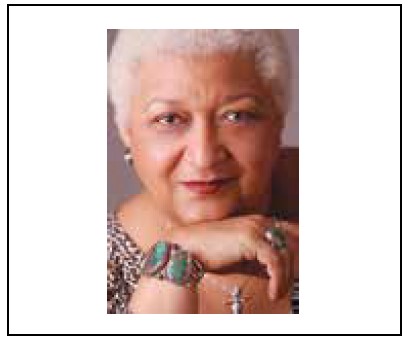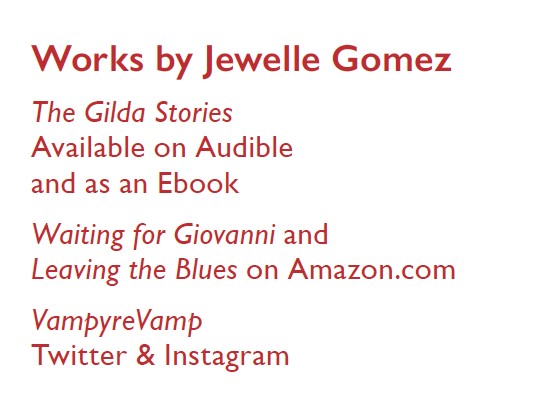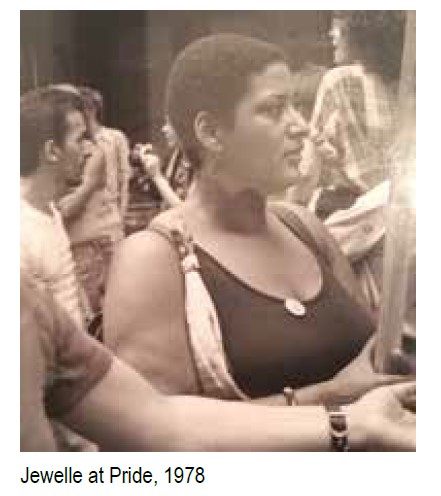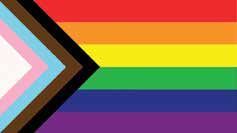
By Jewelle Gomez–
Do I still believe in Pride?
Despite the incursion of corporate interests and cheap beer, my short answer is yes. It was decades ago that I joined my first Pride march in New York City and now I’m always in the grandstand for the SF Pride parade. So, I can’t wait until we’re back in the streets again next year.
There are a bunch of things that I love, but in general it’s the visibility of LGBTQ+ people in the parade, in the newspapers, on television that is most significant to me. It’s hard for many folks of a younger age to remember how much of the queer community was forced to live our lives in shadow and disguise in order to keep our jobs, homes, and families. The post-traumatic stress that is engendered from living a double life has yet to be fully explored but no doubt it leaves a psychological/emotional footprint that damages our interior lives as well as warps our image in the general public.

Visibility is important not because we’re exhibitionists (although why not!). I used to think visibility helped others recognize us as fully human rather than a scary abstraction. But we now know some folks will never see anyone they’ve already decided is dangerous. But visibility is crucial for our own sense of self and to help other Queer people have role models so they can survive those shadows.
The visibility provided by monuments is currently being examined by social equity activists across the country. Some Confederate statues erected in the South long after the Civil War in order to intimidate African Americans have been ripped from their bases. Native Americans who’ve endured the diminishment of Indigenous culture way beyond John Wayne movies have instigated similar actions. After years of their organizing, images of defeat are making way for other signs of the endurance of Native Culture; signs of Native Pride.

The Pride flag is so significant that we honor Gilbert Baker and his creation. The GLBT Historical Society is currently displaying sections of the original flag Baker created in 1978 ( https://www.glbthistory.org/ ). Gilbert spoke of the flag as a representation of our “tribal, individualistic, and collective vision.” The value of the individualistic representation can be understood by the desire for others to create their own version of the flag—Transpeople, Bi, and BDSM folks each have a variation on the flag. And recently, a progressive flag was created adding stripes for Black and Brown people.
Another fabulous sign of SF Pride is the Rainbow Honor Walk—a series of bronze medallions installed in the sidewalks of the Castro. Where else would you find Federico García Lorca, Sylvester, and Gertrude Stein hanging out together? http://rainbowhonorwalk.org/

Another area tradition, a mural, (newly installed), adorns the wall of the SF LGBT Community Center. Designed by Juan Manuel Carmona and Simon Malvaez, it’s called Queeroes and includes all the colors of the progressive Pride flag. It celebrates many who are near and dear to our hearts: Sylvia Rivera, Juanita MORE!, Sister Roma, James Baldwin, and Honey Mahogany. I’m hoping our legends, Phyllis and Del, put in an appearance before it’s completed.
Just as these symbols are important to remind the non-queer world we will not go away, they are also valuable to us. Whether you grew up in a small town, miles from a queer community center and spent your life hidden from others, or you prance your pierced, semi-naked self through the Castro every weekend—believing in yourself and your tribe must be at the core of all of our survival.
Conservatives are reaching into their deep pockets to try to dismantle the democracy we’ve been striving for. They would see queers go back into the closets, women go back into the kitchen, and people of color return to our side of the tracks. Our mission is to make sure that doesn’t ever happen; and it won’t as long as our flag is waving and Dykes on Bikes are revving their engines.
Jewelle Gomez is a lesbian/feminist activist, novelist, poet, and playwright. She’s written for “The Advocate,” “Ms. Magazine,” “Black Scholar,” “The San Francisco Chronicle,” “The New York Times,” and “The Village Voice.” Follow her on Instagram and Twitter @VampyreVamp
Published on June 24, 2021
Recent Comments